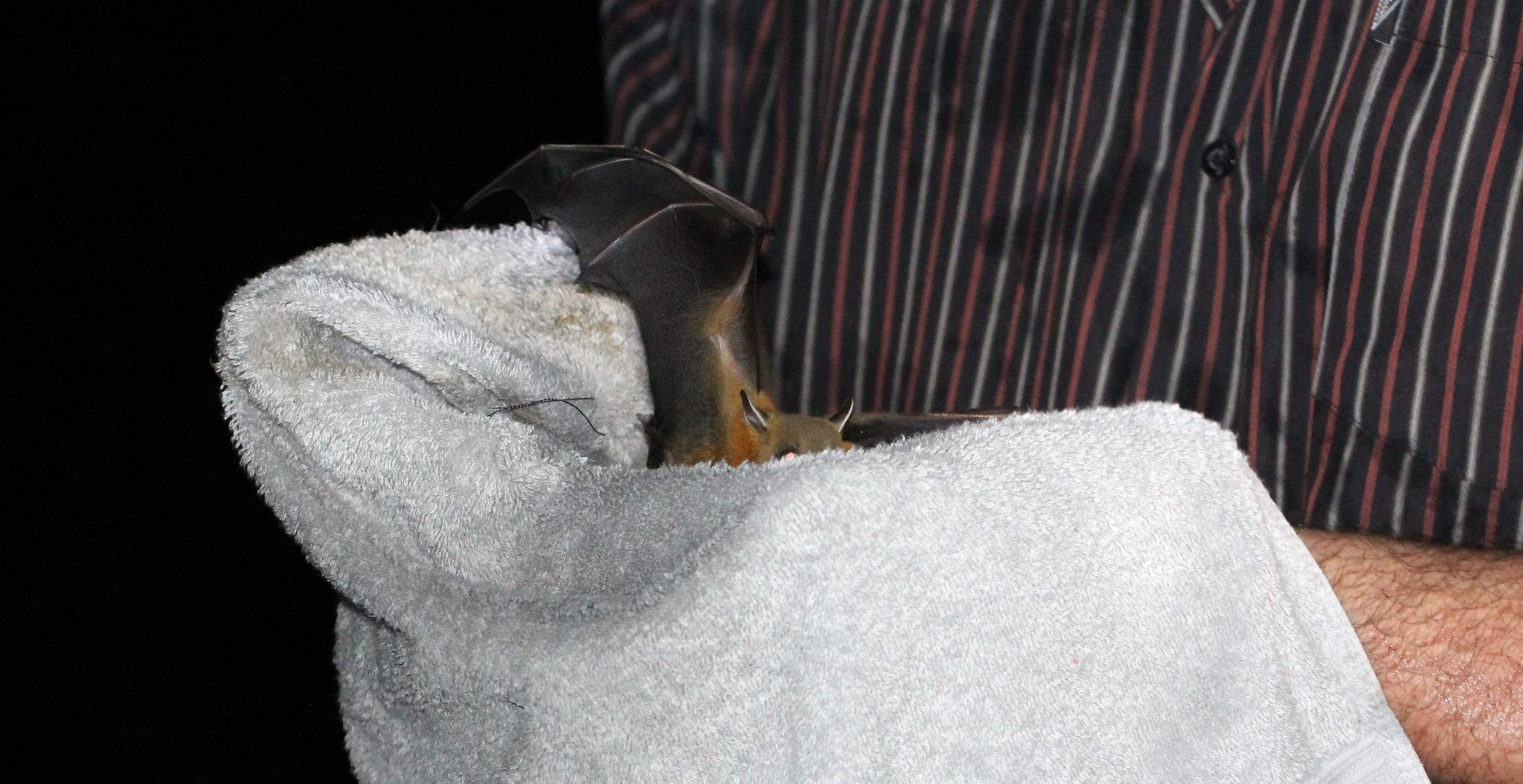
Lesser Short-nosed Fruit Bat (Cynopterus brachyotis) Greater Short-nosed Fruit Bat (Cynopterus sphinx)
Genus Cynoptera - the Megabat Fruit Bats
Cynopterus (Latin meaning: ״flying dog״) is a genus of megabats. The cynopterine section is represented by 11 genera, five of which occur in Malaysia, namely, Chironax, Balionycteris, Penthetor, Dyacopterus, and Cynopterus. About 30 names for Cynopterus species have been proposed, but only 16 are taxonomically valid forms.
Species within this genus are:
Genus Cynopterus
Lesser short-nosed fruit bat (C. brachyotis)
Horsfield's fruit bat (C. horsfieldii)
Peters's fruit bat (C. luzoniensis)
Minute fruit bat (C. minutus)
Nusatenggara short-nosed fruit bat (C. nusatenggara)
Greater short-nosed fruit bat (C. sphinx)
Indonesian short-nosed fruit bat (C. titthaecheilus)
During a survey of Cynopterus brachyotis, it was uncovered that a bat coronavirus (Betacoronavirus) is closely related to the bat coronavirus Rousettus bat coronavirus HKU9 species found in Leschenault's rousette which was discovered in the Guangdong and Yunnan provinces.
The Lesser Short-nosed Fruit Bat (Cynopterus brachyotis) is a species of megabat within the family Pteropodidae.[2] It is a small bat that lives in South Asia and Southeast Asia. It weighs between 21 and 32 grams (0.74 and 1.13 oz), and/or 70 to 127 mm.[3] It occurs in many types of habitat, but most frequently in disturbed forest, including lower montane forest and tropical lowland rain forest, plus gardens, mangroves, and vegetation on beaches.
The lesser short-nosed fruit bat[12] type specimens were collected from the Dewei River in Borneo on September 12, 1836, and at Naga Cave near Jammut on the Teweh River, Borneo.
They are widely distributed in Sri Lanka, southwest and northeast India, Bangladesh, Andaman and Nicobar Islands, southern China, southern Burma, Indochina, Thailand, the Malay Peninsula, Sumatra, Java, Bali, Sulawesi, the Philippines and also on the Lesser Sunda Islands. They are found from sea level up to 1600 m in Borneo. The nominate subspecies, C. b. brachyotis, is distributed in Borneo, Lombok, Peninsular Malaysia, the Philippines and Sulawesi. It is found widespread from sea level to 1,600 meters in altitude. C. b. altitudinis is confined to the highlands of Peninsular Malaysia, from the Cameron Highlands to Gunung Bunga Buah. C. b. brachysoma is found on the Andaman Islands; C. b. cylonensis in Sri Lanka; C. b. concolor in Enggano; C. b. hoffetti in Vietnam; C. b. insularum on the Kangean Islands; C. b. javanicus on Java; and C. b. minutus on Nias.
Sunda or Lesser Short-nosed Fruit Bat (Cynopterus brachyotis) from Koh Lanta Thailand - my place and in poacher's nets






























































Greater & Lesser Short-nosed Fruit Bat (Cynopterus sphinx & C. brachyotis) Udawalawa National Park Sri Lanka







































The Greater Short-nosed Fruit Bat (Cynopterus sphinx), or short-nosed Indian fruit bat, is a species of megabat in the family Pteropodidae found in South and Southeast Asia.
These bats have a relatively long snout. Their upper parts are brown to grey-brown with paler under parts. The fur is very fine and silky. The ears and wing bones of C. sphinx are edged in white. Lower cheek teeth rounded without accessory cusps. The wingspan of the adult is about 48 cm. Juveniles are lighter than adults. Average forearm length is 70.2 mm (64–79 mm).
The greater short-nosed fruit bat is found from Pakistan to Vietnam. It is common in tropical forests and areas where fruit crops are cultivated. They can also be found in grasslands and mangrove forests. They typically nest high in palm trees. The bats chew the fronds of the palms to construct fairly simple tents. These bats are also known to construct tents by closely interweaving the leaves and twigs of creeping vines which cover buildings, but such nests are constructed only when palms are not available.
Greater Short-nosed Fruit Bat (Cynopterus sphinx) Fisherman Cave Mu Koh Libong, Southern Thailand































Cynopterus sphinx - Greater Short-nosed Fruit Back - Baan Maka Petchaburi Thailand - note the Tent-making in the palm leaves in the background of these images.


















Horsfield's Fruit Bat (Cynopterus horsfieldii)
Horsfield's Fruit Bat (Cynopterus horsfieldii) is a species of megabat native to South East Asia. It is named for Thomas Horsfield, an American naturalist who presented the type specimen to the British Museum.
Horsfield's fruit bat is a medium-sized megabat, intermediate in size between flying foxes and pygmy fruit bats. Adults weigh around 55 to 60 grams (1.9 to 2.1 oz), and have light-grey to brown fur, with a reddish-brown or orange mantle around the shoulders. In some males, the mantle extends across the chest, and the fur is often brighter in colour than in females. The rim of the ears and the skin overlying the metacarpals and phalanges within the wing are white. Juveniles have a more bland coat pattern, with uniformly dull buff or grey fur.
The bats have a short, broad snout, ending in a pair of almost tubular nostrils. Both the eyes and ears are large, although the latter have a simpler structure than in most other bats, and lack tragi. The wings have a low aspect ratio and high wing loading, typical of many megabats, and indicating a relatively slow flight speed and moderate manoeuvrability.
Horsfield's fruit bat is found in Thailand, Indonesia, Malaysia, and Brunei. Within this region, it inhabits a broad range of lowland habitats, from dense primary rain forest to agricultural land and suburban gardens.
The four recognised subspecies are:
C. h. harpax - Thailand, peninsular Malaysia, Sumatra
C. h. horsfieldii - Java and islands east to Sumbawa
C. h. persimilis - Borneo
C. h. princeps - Nias

Horsfield's Fruit Bat (Cynopterus horsfieldii) Bukit Lawang Gunung Leuser NP Sumatra Indonesia































